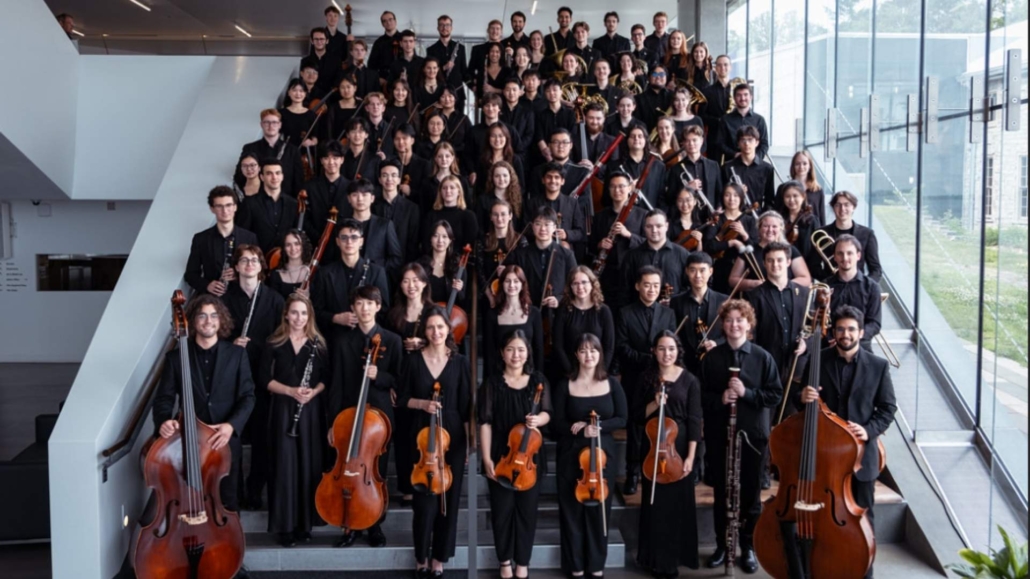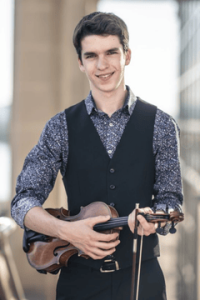Program Notes
Nicholas Denton Protsack (1994-)
Across the Vaulted Night
It is November 2022. I am standing at a viewing area on the downtown pier of Wellington city harbour to watch a total lunar eclipse. I have been living in New Zealand for just over a week, after relocating from western Canada. Waiting for the eclipse to begin, I gaze at the night sky, which luckily is dazzlingly clear. Orion is the first constellation I recognize, except something about it immediately confuses me: it is upside down. I then turn my attention to the still radiant full moon, studying each of its distinctive craters. It is also clearly upside down. For a moment, I feel an almost dizzying sense of disorientation before realizing that this makes complete sense. I am in the southern hemisphere for the first time; much of this is the night sky that I know, but my point of reference means it is now flipped.
It is May 2024. I am in Kelowna, British Columbia, gazing up at the night sky once again. I am joined by my wife, Kate, and two friends, all of whom are coincidentally from New Zealand. They are not concerned with the fact their night sky has been flipped, however, as we are all instead watching an incredible display of the aurora borealis. The solar storm that triggered this aurora is one of the strongest in decades. As a result, the northern and southern lights are seen across the globe, making international headlines. For several days afterward, I exchange pictures of the aurora with friends from around the world. Although we are separated by continents and oceans, we have all experienced variations of the same virtuosic light show, occurring some hundred kilometres overhead.
The night sky, and especially the liminal region where earth’s atmosphere merges with space, is something that fascinates me. It is a place that exists and expresses itself in terms of intense radiation, temperature, and light. It also has a profound ability to invoke awe—to humbly remind us of our shared location in the cosmos—making what often feels like a very large and complex world seem little more than a point floating through space and time. Nevertheless, just like any other place on and around earth, the presence of humans is readily apparent. Incessantly blinking satellites transmitting incalculable amounts of data, space debris, as well as light and radio spectrum pollution increase in magnitude with each passing year. Across the Vaulted Night (2025) for symphony orchestra, is intended to embody all these aspects of the world above us.
Notes by Nicholas Denton Protsack
Sergei Prokofiev (1891-1953)
Violin Concerto No.2 in G Minor, op.63
Sergei Prokofiev completed Violin Concerto No. 2 in 1935 as he was awaiting repatriation to his
native Russia, having composed Violin Concerto No. 1 around the time that he first departed
(with official permission) in 1917. For that reason, Violin Concerto no. 2 differs from the music
Prokofiev wrote while living abroad in the United States and in France during the intervening
years, in its modest dimensions and traditional form designed to convince Stalin that he no
longer had an artistic use for “decadent formalism”.
Very shortly before Prokofiev’s permanent relocation, and the Spanish Civil War, Violin
Concerto no. 2 was premiered in Madrid, Spain in December of 1935 by French violinist David
Soetens and the Madrid Symphony Orchestra led by Enrique Fernández Arbós. In what must
have been a refreshing surprise for the composer at the time, the Spanish loved the work so
much that a special delegation of musicians was sent to personally thank Prokofiev. This
premiere, with its international cohort of musicians, undoubtedly helped Prokofiev believe, at
least temporarily, that he could act as a musical ambassador between Europe and Soviet
Russia.
It was also during this period that Prokofiev wrote Peter and the Wolf, Lieutenant Kijé, and
Romeo & Juliet, three of his most famous works. In fact, there are numerous musical
references to Romeo & Juliet throughout this concerto, particularly in the second movement,
and more broadly in how the solo violin part is constructed to evoke the ballet. This era of
composition in Prokofiev’s life demonstrates his extraordinary ability to adapt to the
circumstances, political and otherwise, dictating his music-making. Working with Diaghilev’s
Ballets Russes in Paris after a brief stay in the United States, Prokofiev was inspired to write
opera, ballet, and large symphonic works such as Symphony No. 3 The Fiery Angel which
showcases his interest in expressionism and large musical forms.
However, much of his work at this time experienced production issues, an unenthusiastic
reception, and of course drew negative attention from the Soviets. With an economic
depression underway during the 1930s in the United States and Europe, which dampened his
aspirations as an opera composer while forcing him to rely on touring income as a concert
pianist, and tensions that soon led to World War II, Prokofiev sought a spiritual path in Christian
Science that engendered a newfound simplicity and sincerity in his composition that seemed
to pave the way for resettling in Russia.
The rules governing the arts were somewhat relaxed during the War years in Soviet Russia, and
Prokofiev enjoyed a period of creativity and freedom in the works he produced. However, he
found himself once again at odds with the Communist Party following the war and several of
his compositions were banned. Nevertheless, he is considered one of the greatest composers
of modern classical music, and both the State Music Academy and the Airport in Donetsk
Oblast in Ukraine, where Prokofiev was born, have been named in his honour.
Program Note by Tamsin Lorraine Johnston
Dmitri Shostakovich (1906-1975)
Symphony No.10 in E minor, op.93
Written for large orchestra, there is some controversy as to the exact completion date for
Symphony No. 10 by Dmitri Shostakovich. The premiere was performed by the Leningrad
Philharmonic Orchestra under the baton of Yevgeny Mravinsky (1903-1988) in December 1953,
following the death of Joseph Stalin in March of that year. While some sources indicate that
Symphony No. 10 was composed quickly during the summer of 1953, there is also evidence
that Shostakovich had written the work in 1951 or earlier.
Symphony No. 10 straddles parallel worlds and is crafted from tension between opposing
forces. In 1948, Shostakovich was publicly denounced for the second time by the Communist
Party for writing inappropriate and formalist music, meaning that his music was too abstract,
not sufficiently Russian, and did not fulfill the requirement of appealing to the masses. At this
point, Shostakovich’s music had not yet gained traction in the West. Furthermore, composers
in Europe and North America had largely moved away from the four-movement symphonic
form in which Shostakovich was still working.
The perception of an anti-Stalin political statement in the form of a musical work from a Soviet
composer without doubt has drawn attention and speculation to Symphony No. 10. While it is
widely accepted that the despairing slow movements and the relentless marches that
characterize many of Shostakovich’s compositions are portrayals of the horrors of Stalin’s
regime, there are many clues in Symphony No. 10 that paint a picture of Shostakovich’s inner
world. While daily life for the composer was coloured by the suffering of his fellow Soviet
citizens, Shostakovich was influenced by the work of Gustav Mahler (1860-1911), particularly
the beautiful symphonic song cycle Das Lied von der Erde, a work which would have
represented the pinnacle of decadence to Russian authorities at the time. Shostakovich also
references his own song setting of a poem by Alexander Pushkin (1799-1837) called What
Does My Name Mean to You?
As engrossing as is the political context for the creation of Symphony No. 10, Shostakovich
was explicit in depicting his own narrative using the musical cryptogram D-S-C-H to represent
himself. DSCH is a musical motif made up of the notes D, E flat, C, and B natural using
German musical notation. DSCH appears in many of Shostakovich’s works; in Symphony No.
10 it is presented alongside a musical theme representative of the pianist and composer Elmira
Nazirova (1928-2014), with whom he was in love. Throughout the 1940s and 1950s,
Shostakovich was connected to several women, of whom two were his students including
Nazirova. It’s believed that his feelings for Nazirova were unrequited.
Seen through the lens of the twenty-first century, a professor signaling romantic interest in a
student through a series of letters represents highly questionable behaviour at best and
possible exploitation of a power dynamic. By using music to preserve a sense of longing and
hope during a desperate era, Shostakovich shows us that to be vulnerable is to be human.
Program Note by Tamsin Lorraine Johnston




